You might think Wyoming’s brutal winters and scorching summers make native gardening impossible, but these hardy plants actually thrive in conditions that kill most garden varieties. Native species like Rocky Mountain Penstemon and Wyoming Big Sagebrush have spent thousands of years developing survival strategies that’ll make your landscaping nearly maintenance-free. What’s surprising isn’t just their toughness—it’s how these plants can transform your yard into something that actually works with nature instead of fighting it.
Contents
- 1 Wyoming’s Harsh Weather Challenges
- 2 Hardy Wyoming Wildflowers
- 3 Drought-Tolerant Native Trees
- 4 Wyoming’s Adaptable Native Shrubs
- 5 Selecting the Right Native Plants for Your Garden
- 6 Frequently Asked Questions
- 6.1 How Long Does It Take for Native Wyoming Plants to Establish?
- 6.2 Can Wyoming Native Plants Survive in Containers or Raised Beds?
- 6.3 What Soil Amendments Work Best for Wyoming Native Plants?
- 6.4 When Is the Optimal Time to Plant Native Species in Wyoming?
- 6.5 Do Wyoming Native Plants Require Special Fertilizers or Nutrients?
Wyoming’s Harsh Weather Challenges
When you’re planning a garden in Wyoming, you’re fundamentally preparing for a botanical battle against some of the country’s most challenging weather conditions. You’ll face extreme temperature swings from 95°F summers to -40°F winters, with temperatures dropping 5.5°F per 1,000 feet of elevation.
Your growing season lasts only 125 days between frosts. Spring temperatures have risen 2.9°F since 1920, creating unpredictable freeze-thaw cycles that stress plants. Cold air drainage in valleys creates microclimates where temperatures drop lower than on nearby mountainsides, affecting plant selection strategies.
Wyoming’s arid climate delivers inconsistent precipitation, while persistent winds accelerate moisture loss. Successful climate adaptation requires selecting plants with proven weather resilience against these relentless conditions.
Hardy Wyoming Wildflowers
Wyoming’s harsh climate demands exceptional plant resilience. From iconic state flowers to sagebrush community blooms, mountain-adapted species to early-blooming varieties, these hardy wildflowers define the state’s natural beauty. These native species serve as crucial pollinator support systems, sustaining bees, butterflies, and other essential insects throughout the growing season.
Indian Paintbrush
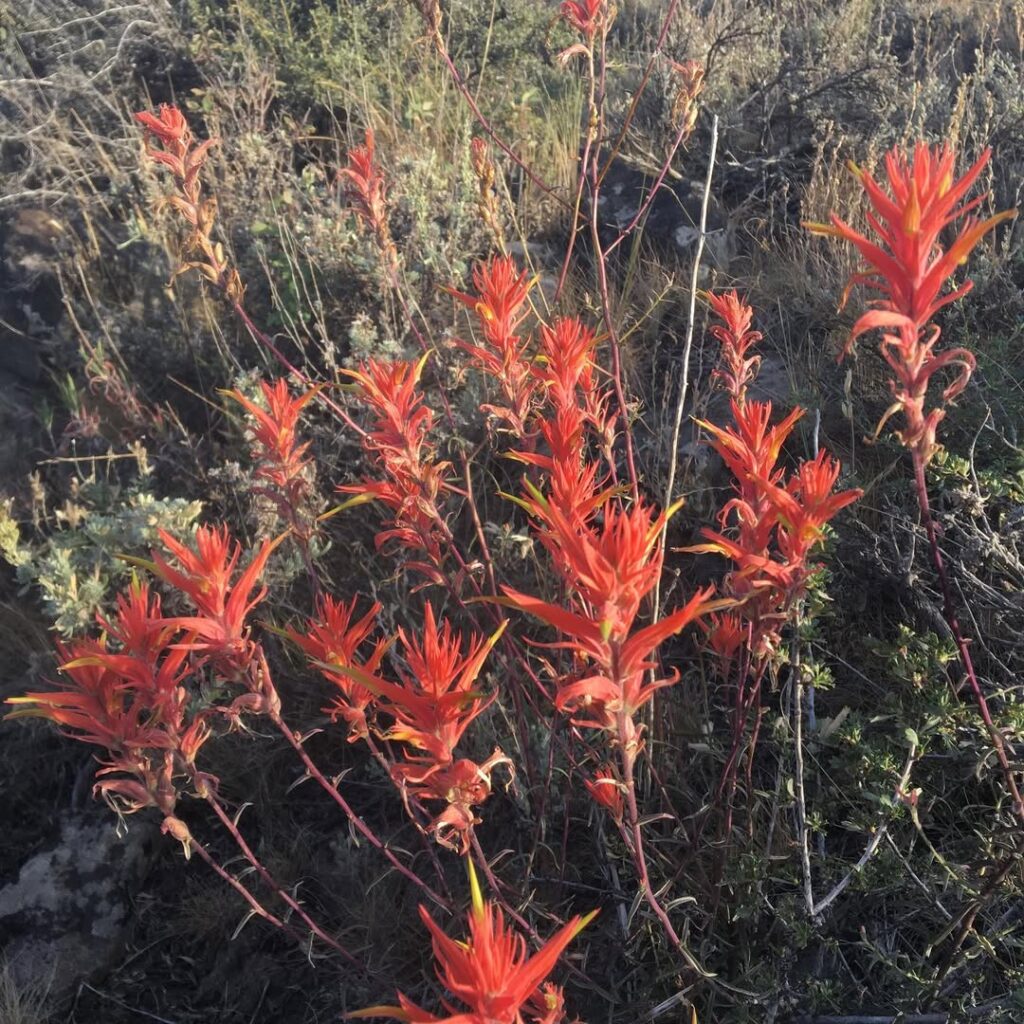
Indian Paintbrush is a striking native wildflower that graces Wyoming’s prairies and open woodlands with brilliant red, orange, or yellow bracts. This hardy biennial or annual grows up to 18 inches tall, forming distinctive clumps with hairy stems topped by colorful flower clusters. As a hemiparasite, it uniquely combines photosynthesis with parasitism, using specialized structures to tap into nearby host plants’ roots for additional water and nutrients.
This remarkable adaptation allows Indian Paintbrush to thrive in Wyoming’s challenging conditions while supporting local pollinators, especially hummingbirds. Though difficult to cultivate independently due to its parasitic nature, it naturalizes beautifully in wildflower gardens when suitable host grasses and prairie plants are present. The plant serves as a larval host for the Buckeye butterfly, adding to its ecological value in native landscapes.
- Hardiness: USDA zones 3-9, extremely cold tolerant
- Light: Full sun preferred, tolerates partial shade
- Water: Low to moderate; prefers spring moisture with summer dryness
- Soil: Well-drained, adapts to poor soils; medium moisture preferred
- Fertilizer: None needed; obtains nutrients through host plant parasitism
- Pest/Disease Resistance: Excellent; highly resistant due to parasitic adaptations
- Growth Rate: Moderate; biennial lifecycle with second-year flowering
Pale Agoseris
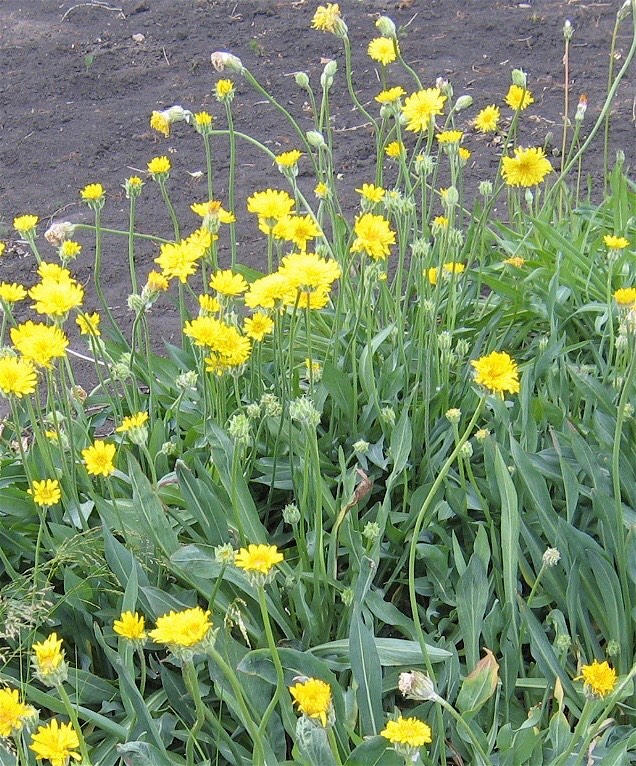
The Pale Agoseris, often called the False Dandelion, is a striking Wyoming native wildflower known for its delicate yellow blooms and slender, grass-like foliage. This hardy perennial thrives in open meadows, foothills, and sagebrush plains, adding a subtle yet elegant presence to Wyoming’s diverse landscapes.
Unlike true dandelions, Pale Agoseris produces a single flower head per stem, with bright yellow ray florets that lack disc florets. Its deep taproot allows it to withstand drought conditions, making it well-suited for Wyoming’s arid climate. This resilient wildflower supports pollinators such as bees and butterflies, contributing to the ecological health of its native habitat.
- Hardiness: Zones 3-8, highly adaptable to Wyoming’s cold winters
- Light: Prefers full sun, tolerates partial shade
- Water: Low to medium moisture needs, drought tolerant once established
- Soil: Well-drained soils preferred, thrives in sandy or rocky terrain
- Fertilizer: No fertilization required, naturally adapted to nutrient-poor soils
- Pest/Disease Resistance: Excellent resistance due to native adaptation
- Growth Rate: Moderate perennial growth, forming basal rosettes before flowering
Wild Bergamot

Wild bergamot is a hardy native perennial that brings both beauty and functionality to Wyoming gardens. This aromatic herb produces clusters of distinctive lavender, pink, or white flowers that resemble ragged pompoms, blooming from June through early August atop sturdy 2-5 foot stems. The plant’s square, hairy stems support dark green triangular leaves that often develop attractive red coloring in fall.
Beyond its ornamental value, wild bergamot serves as an exceptional pollinator plant, attracting bees, butterflies, hummingbirds, and other beneficial insects throughout its extended blooming period. Its high deer resistance and adaptable nature make it ideal for naturalized settings, native plant gardens, and mixed borders. The aromatic foliage and edible flowers also provide traditional uses for teas, seasonings, and culinary applications. Wild bergamot has been historically valued for treating respiratory ailments and various health conditions.
- Hardiness: Very hardy perennial, dies back to ground in winter with new spring growth
- Light: Full sun to partial shade
- Water: Average moisture requirements, drought tolerant once established
- Soil: Average, well-drained soils; prone to mildew in poorly aerated conditions
- Fertilizer: Low maintenance, does not require supplemental feeding
- Pest/Disease Resistance: High deer resistance, some cultivars resist mildew
- Growth Rate: Moderate, slowly expands via short rhizomes
Rocky Mountain Beeplant
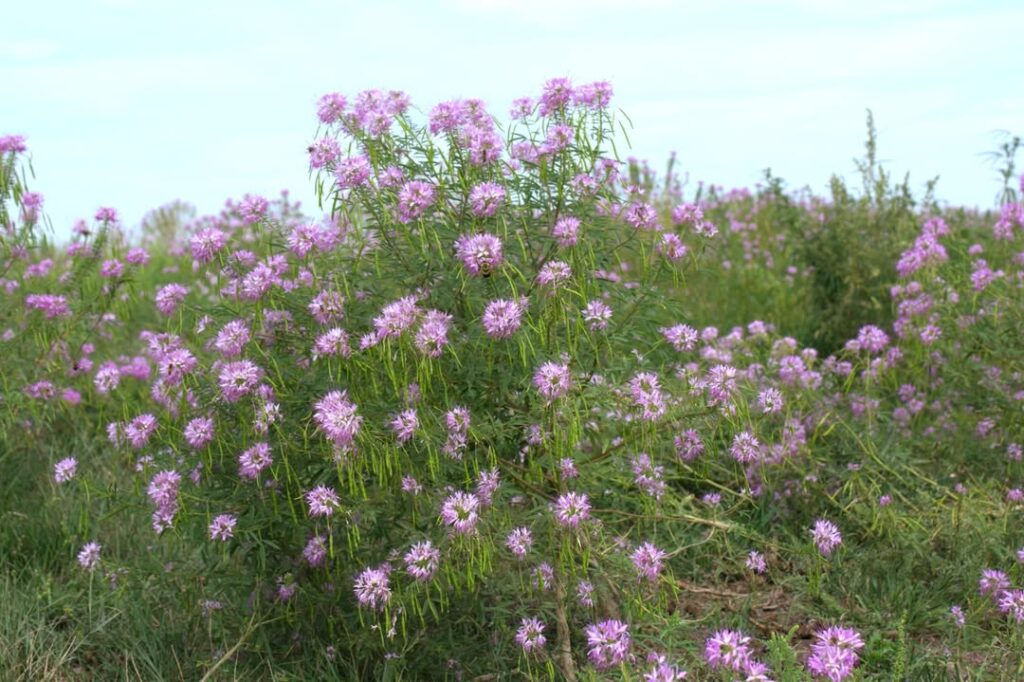
Rocky Mountain Beeplant is a striking native wildflower that exemplifies resilience in Wyoming’s challenging climate. Growing 3-5 feet tall with distinctive pink to reddish-purple flower clusters, this annual blooms from July to August, producing abundant nectar that supports diverse pollinator populations. Its adaptation to harsh conditions and cultural significance make it an excellent choice for native landscaping.
Historically valued by Native Americans and early settlers as both food and medicine, this hardy plant requires minimal care once established. The elongated stamens extending beyond petals create an distinctive appearance, while its ability to thrive in gritty, arid soils demonstrates remarkable drought tolerance ideal for Wyoming gardens. The plant produces narrow capsules up to 2 inches long containing dark, ovoid seeds that ensure natural propagation.
- Hardiness: Annual plant adapted to Wyoming’s short growing seasons and extreme temperature fluctuations
- Light: Prefers partially sunny conditions for best growth and flowering
- Water: Drought tolerant once established; minimal supplemental watering needed
- Soil: Thrives in gritty, arid, well-draining soils typical of Wyoming landscapes
- Fertilizer: Low maintenance; adapted to nutrient-poor native soils, minimal fertilization required
- Pest/Disease Resistance: Hardy native with natural resistance to local pests and diseases
- Growth Rate: Moderate to fast annual growth, reaching 3-5 feet by mid-summer blooming period
Prairie Smoke
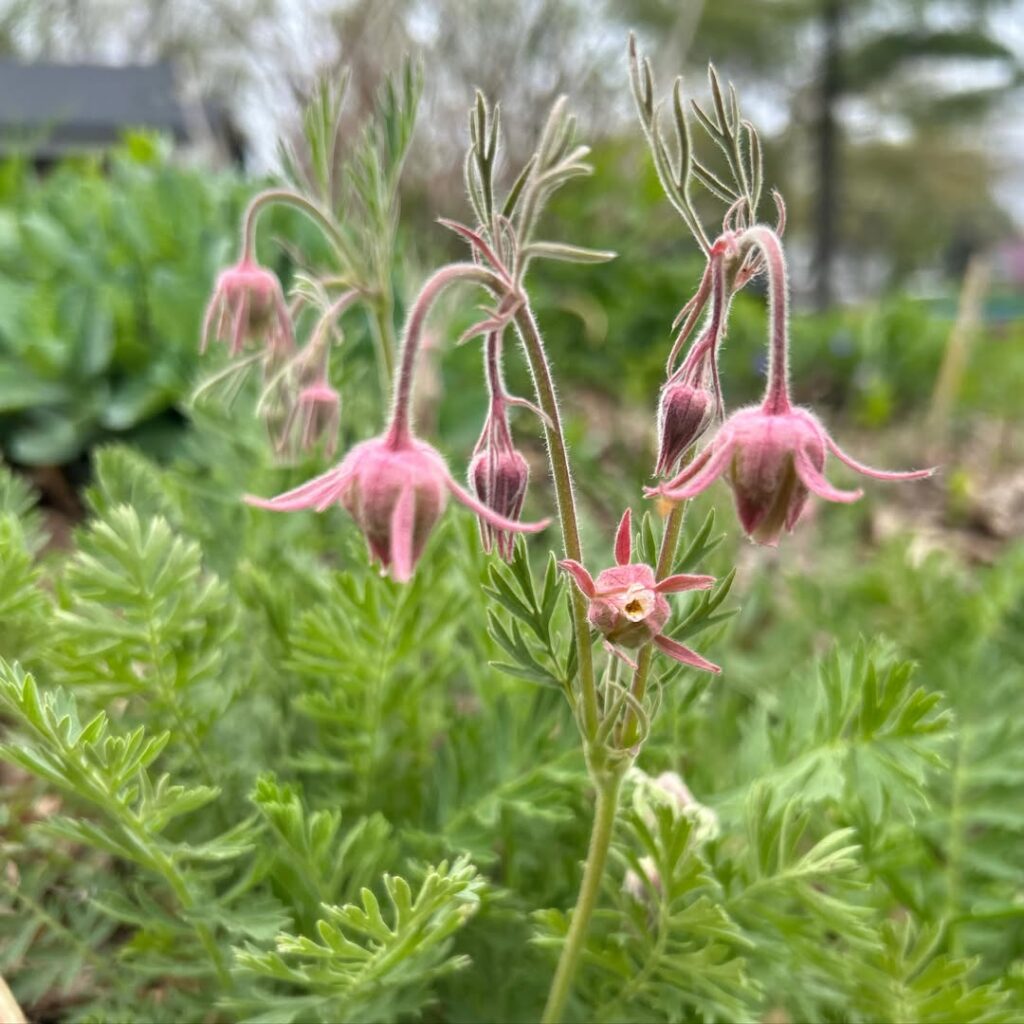
Prairie Smoke is a charming native wildflower that brings unique character to Wyoming landscapes. Standing 8-18 inches tall, this hardy perennial produces distinctive nodding, reddish-pink bell-shaped flowers in clusters of three during mid-to-late spring. The plant’s most striking feature emerges after blooming, when seed heads transform into feathery, smoke-like plumes that persist through summer, giving the plant its evocative name.
With bright green, pinnately lobed leaves that form attractive basal rosettes and often turn deep red in fall, Prairie Smoke offers multi-season interest. The semi-evergreen foliage provides visual appeal even during dormant periods. This slow-spreading groundcover thrives in challenging conditions and serves as valuable habitat for early-season pollinators while creating naturalized beauty in rock gardens, prairie restorations, and wildflower meadows. As a member of the Rosaceae family, Prairie Smoke shares botanical characteristics with roses and other familiar garden plants.
- Hardiness: Extremely hardy to Wyoming’s temperature extremes
- Light: Full sun to part shade
- Water: Low to moderate water needs; drought tolerant
- Soil: Well-drained soils; suitable for challenging sites
- Fertilizer: None required; adapted to native soil conditions
- Pest/Disease Resistance: Excellent resistance; very resilient
- Growth Rate: Slow spreading via short rhizomes
Drought-Tolerant Native Trees
Wyoming’s harsh climate demands trees that can withstand drought, temperature extremes, and poor soils while supporting local ecosystems and providing practical landscape benefits. Native species must also tolerate Wyoming’s alkaline soil conditions, which often exceed the optimal pH range of 6 to 7 that many trees prefer.
Eastern Red Cedar

Eastern Red Cedar is a resilient native conifer well-suited for Wyoming’s challenging climate. This adaptable tree thrives in various soil conditions, from dry sandy soils to alkaline clay, making it an excellent choice for windbreaks and shelterbelts. With mature heights reaching 35-80 feet and a distinctive pyramidal shape, it provides valuable wildlife habitat and food sources.
Despite its slow to moderate growth rate, Eastern Red Cedar offers exceptional drought tolerance once established and withstands both extreme cold and intense summer heat. Its dense foliage provides year-round shelter for wildlife, while the berry-like cones on female trees serve as important food sources for birds and small mammals. The tree produces attractive silver-blue berries in fall that are particularly appealing to various bird species.
- Hardiness: Zones 3-9, tolerates Wyoming’s extreme temperature fluctuations
- Light: Full sun preferred, tolerates partial shade
- Water: Medium to high drought tolerance once established, avoid persistently wet soils
- Soil: Adaptable to various soil types including rocky, clay, sandy, alkaline, and saline conditions
- Fertilizer: Low maintenance, no special fertilizer requirements
- Pest/Disease Resistance: Moderate resistance; susceptible to cedar-apple rust, cankers, webworms, and borers
- Growth Rate: Slow to moderate, approximately 35 feet in 20 years under favorable conditions
Rocky Mountain Juniper
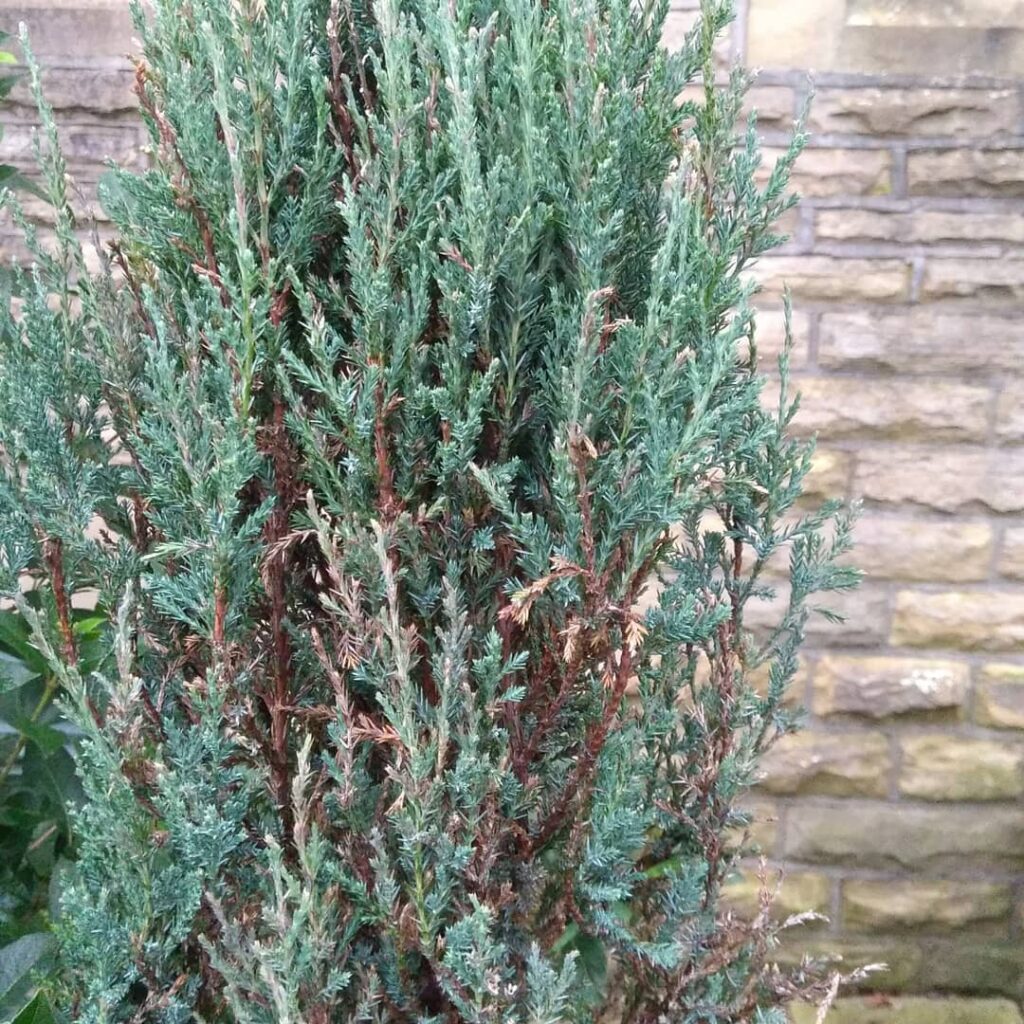
Rocky Mountain juniper is Wyoming’s most common native juniper, thriving in the state’s arid climate with remarkable drought tolerance. This slow-growing evergreen typically reaches 12-15 feet at maturity, featuring distinctive blue-green scale-like foliage and berry-like cones that provide vital wildlife food. Found below 6,000 feet elevation on south-facing slopes and rocky ridges, it forms an essential component of Wyoming’s native plant communities.
The species excels in harsh conditions where many trees struggle, requiring minimal water once established and tolerating extreme temperature fluctuations. Its dense wood and compact growth habit make it valuable for windbreaks and erosion control, while its wildlife benefits support local ecosystem health. The tree’s aromatic wood has been traditionally valued for lumber, fence posts, and fuel due to its natural durability and pleasant scent.
- Hardiness: Extremely winter hardy, tolerates harsh temperature fluctuations typical of Wyoming
- Light: Full sun
- Water: Very low water requirements once established; thrives with 8-20 inches annual precipitation
- Soil: Excessively well- to well-drained, coarse- to medium-textured soils; sandy, rocky, or gravelly substrates; pH 5.0-8.5
- Fertilizer: Not required; adapted to nutrient-poor soils
- Pest/Disease Resistance: Generally resistant but susceptible to fire damage due to volatile oils
- Growth Rate: Slow growth resulting in dense, compact form
Quaking Aspen
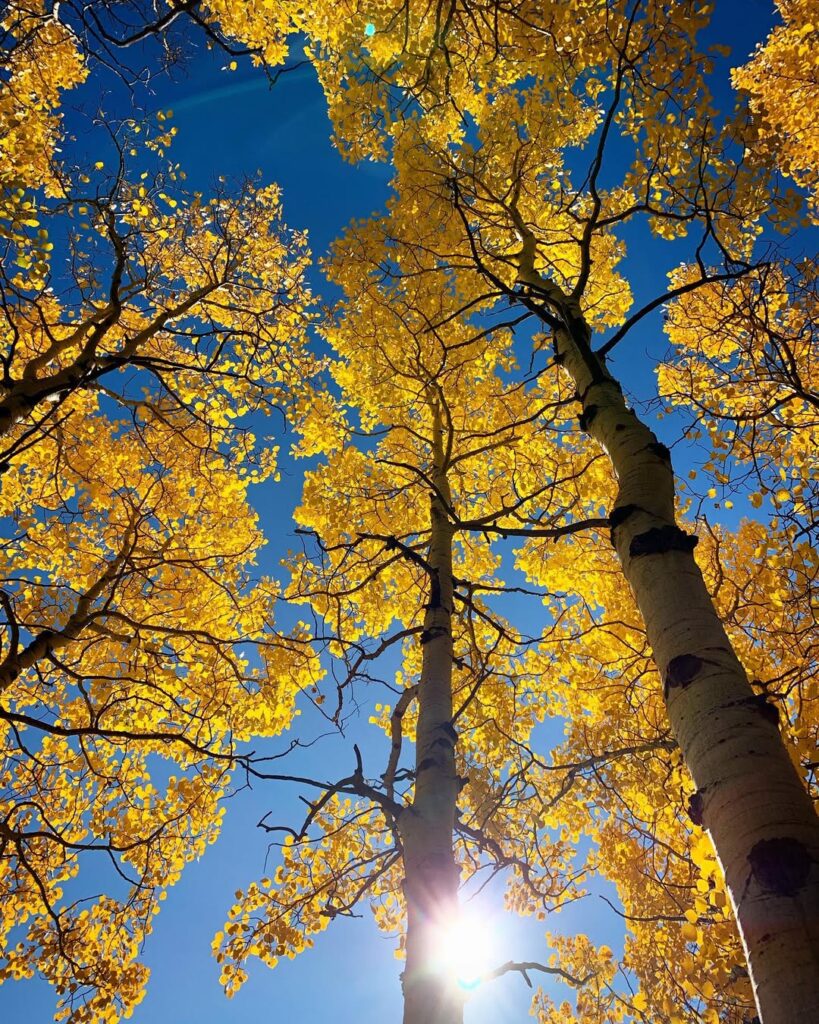
Quaking aspen is a fast-growing native tree with medium drought tolerance that thrives throughout Wyoming’s mountains and foothills. While mature trees adapt better to dry conditions than seedlings, aspens prefer sites with adequate moisture and may struggle in prolonged drought without supplemental water. These pioneer species regenerate primarily through root suckering, forming large clonal stands that can persist for centuries despite individual tree mortality. However, aspens typically have a short lifespan of around 20 years, particularly when stressed by pests and diseases.
- Hardiness: Cold hardy throughout Wyoming; performs best at higher elevations where temperatures are cooler
- Light: Full sun to partial shade
- Water: Requires consistent moisture; prefers sites with water surplus but avoid standing water or flooding
- Soil: Moist, well-drained, loamy soils high in organic matter; best on silt-plus-clay soils; avoid drought-prone sandy soils
- Fertilizer: Thrives in nutrient-rich soils; benefits from high organic matter content
- Pest/Disease Resistance: Moderate; drought stress increases susceptibility to insects and diseases including Sudden Aspen Decline
- Growth Rate: Fast-growing; young stands quickly establish dense thickets through root suckering
Limber Pine
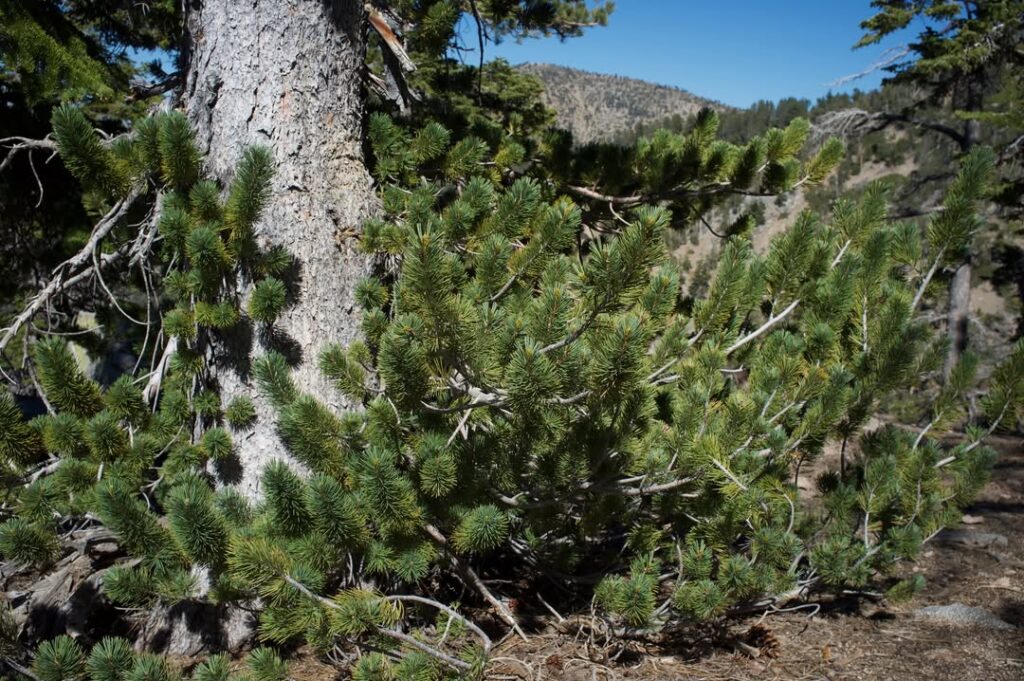
Limber pine stands as one of Wyoming’s most adaptable native conifers, thriving across the widest elevational range of any Rocky Mountain tree species. This truly xeric species demonstrates remarkable resilience, surviving on minimal precipitation while withstanding extreme temperature fluctuations, strong winds, and poor soils. Its flexible trunk and branches allow it to endure heavy snow loads, while deep taproots and mycorrhizal partnerships enhance drought survival.
As a pioneer species, limber pine serves essential ecological functions by stabilizing soils and providing wildlife habitat across Wyoming’s diverse landscapes. Though slow-growing, its longevity and adaptability make it invaluable for conservation plantings and ecosystem restoration in challenging environments. The extremely flexible branches of cultivars like ‘Cheyenne’ can actually be tied in knots without breaking, demonstrating their exceptional wind resistance.
- Hardiness: USDA zones 3-7, tolerates temperatures well below freezing and elevation ranges from 5,250-11,000 feet
- Light: Full sun tolerance, thrives in exposed conditions
- Water: Extremely drought-tolerant, survives on 12 inches annual precipitation, minimal supplemental watering needed except during multi-year droughts
- Soil: Tolerates wide range including rocky, nutrient-poor, and salt-affected soils
- Fertilizer: Generally not required, benefits from ectomycorrhizal associations
- Pest/Disease Resistance: Susceptible to white pine blister rust and mountain pine beetle; tolerates air pollution and salt spray
- Growth Rate: Slow but results in long-lived, wind-firm trees
Ponderosa Pine
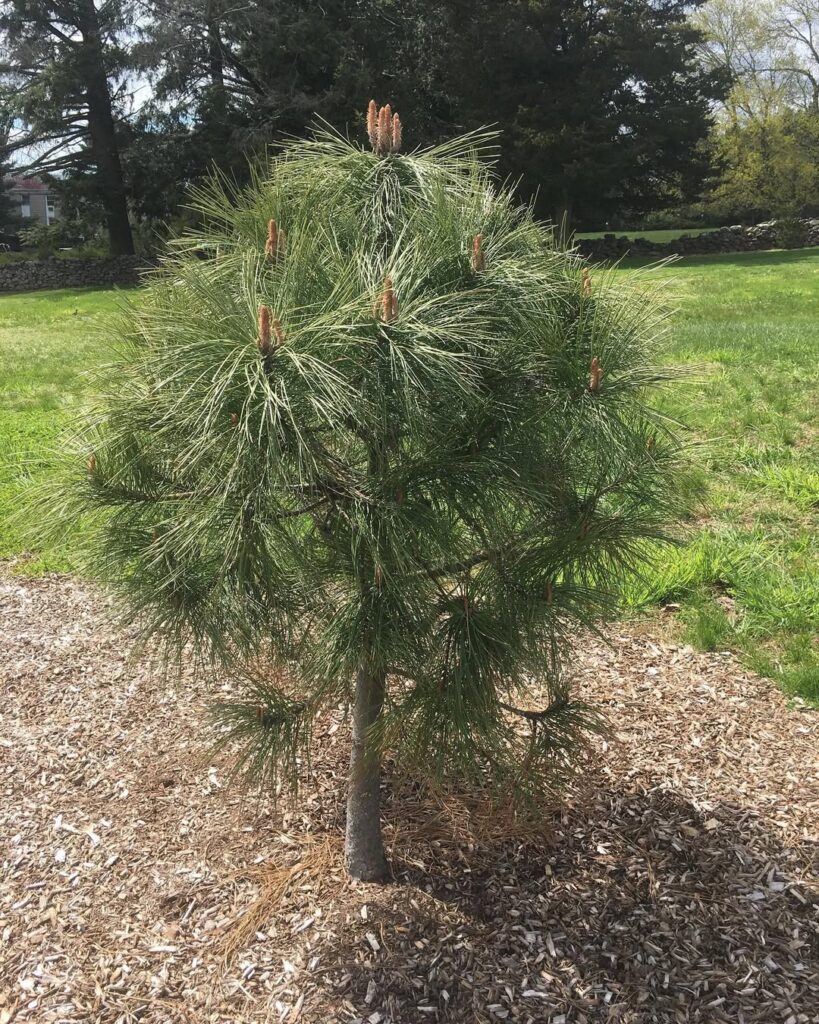
Ponderosa pine is a drought-tolerant native evergreen tree well-adapted to Wyoming’s harsh growing conditions. With its deep root system and ability to withstand high soil surface temperatures, this long-lived conifer thrives in the state’s lower treeline areas and xeric forest systems.
This shade-intolerant species provides excellent value for windbreaks, wildlife habitat, and conservation projects. Its coarse, well-drained soil preferences and medium drought tolerance make it suitable for mine-land reclamation, riparian restoration, and native landscaping throughout Wyoming’s diverse climate zones. Researchers and conservationists can access detailed ecological data about ponderosa pine distribution and habitat requirements through specialized biodiversity databases.
- Hardiness: USDA Zone 3b (-34 to -37°C), may tolerate Zone 3a conditions
- Light: Full sun; shade-intolerant species requiring open, sunny locations
- Water: Medium drought tolerance; distribution closely related to available soil moisture
- Soil: Coarse, well-drained soils preferred; performs poorly on heavy soils; tolerates 4-6 mmhos/cm salinity in sandy soils
- Fertilizer: Not specified; adapted to native soil conditions
- Pest/Disease Resistance: Not specified in available data
- Growth Rate: Relatively rapid growth compared to other conifers suitable for Wyoming
Wyoming’s Adaptable Native Shrubs
Wyoming’s diverse native shrubs offer gardeners structural beauty and year-round interest while thriving in harsh conditions, though they require careful consideration of water needs and proper site selection. These drought-tolerant species can flourish with just 12 inches of natural annual precipitation, making them ideal for the state’s arid climate.
Big Sagebrush
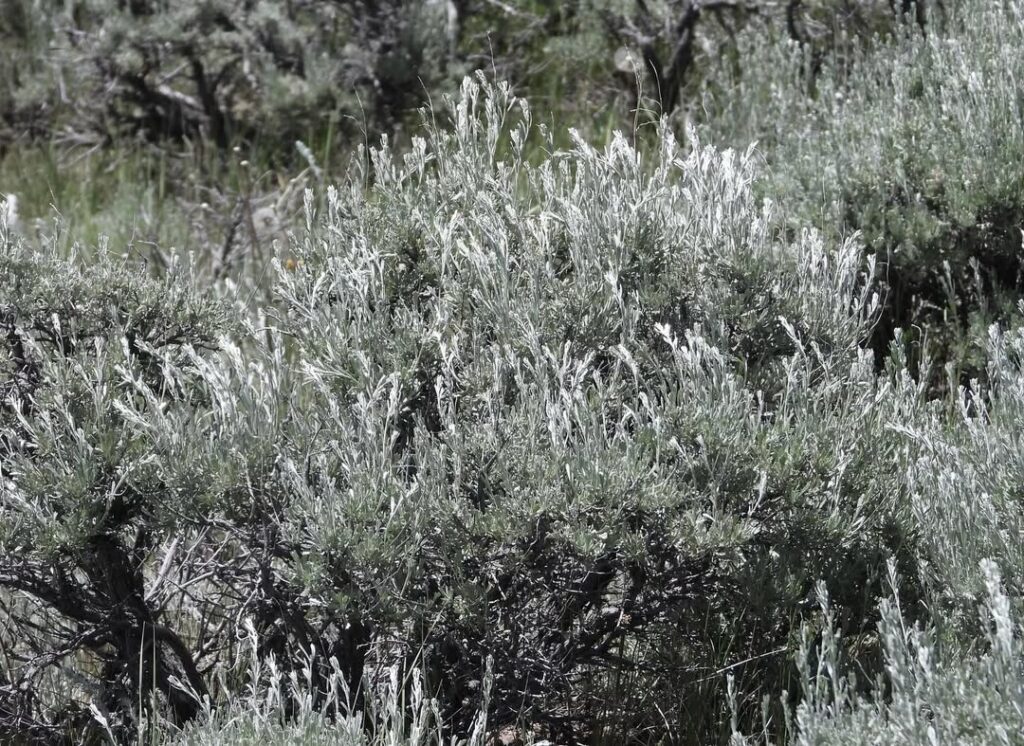
Wyoming Big Sagebrush (Artemisia tridentata wyomingensis) stands as one of the most drought-tolerant and ecologically important shrubs across western rangelands. This evergreen native can reach heights from under 2 feet to 13 feet, depending on site conditions, and is characterized by its wider leaves and multistemmed growth form with thick trunks and irregular crowns.
As a slow-growing, long-lived species that can exceed 100 years, Wyoming Big Sagebrush provides critical habitat for sage grouse and other wildlife while serving as a cornerstone species for revegetation efforts in arid regions. The species demonstrates exceptional soil tolerance, thriving in pH ranges from 5.9 to 10.0 across various soil conditions. Its exceptional adaptability to harsh conditions makes it invaluable for restoration projects across diverse precipitation zones and soil types.
- Hardiness: Extremely hardy, adapted to elevations 2,600-7,200 feet with exceptional drought tolerance
- Light: Full sun exposure preferred for ideal growth and development
- Water: Thrives in low precipitation areas (8-12 inches annually), drought-tolerant once established
- Soil: Well-drained loamy soils with high clay content, tolerates shallow, rocky, or gravelly conditions
- Fertilizer: Adapted to both fertile and infertile soils, typically requires no supplemental fertilization
- Pest/Disease Resistance: Generally resistant to most pests and diseases in native habitat conditions
- Growth Rate: Slow growth rate, reaching maturity over decades with longevity of 40-100+ years
Antelope Bitterbrush

Antelope Bitterbrush is a resilient semi-evergreen shrub native to the intermountain Western United States, growing up to 12 feet tall with distinctive three-lobed leathery leaves and pale-yellow flowers. This hardy plant thrives in Wyoming’s challenging mountain environments, from New Mexico north to British Columbia, establishing itself through deep taproot systems and nitrogen-fixing capabilities.
As an early colonizer of disturbed sites, Antelope Bitterbrush demonstrates remarkable adaptability to harsh conditions while providing essential browse for wildlife. Its intricately branched structure and tolerance of extreme temperatures make it an invaluable component of Wyoming’s native plant communities, particularly in areas with big sagebrush and bluebunch wheatgrass. The plant’s stems often root where they touch the ground, creating natural propagation and helping establish new colonies.
- Hardiness: Extremely hardy, tolerates severe cold and heat extremes across intermountain regions
- Light: Full sun; shade intolerant
- Water: Drought tolerant once established; adapted to arid conditions
- Soil: Thrives in coarse-textured soils, rocky sites, and highly calcareous fine-textured sedimentary soils
- Fertilizer: None needed; has nitrogen-fixing capacity
- Pest/Disease Resistance: Generally resistant; hosts beneficial insects and mites
- Growth Rate: Moderate; functions as early colonizer but biomass productivity declines after 70 years
Three-tip Sagebrush

Three-tip sagebrush is a hardy evergreen shrub perfectly suited to Wyoming’s challenging climate. Distinguished by its deeply three-lobed, silvery-green leaves covered in dense hairs, this aromatic native provides year-round structure in the landscape. The Wyoming subspecies forms a particularly compact, spreading shrub under one foot tall, making it ideal for ground cover applications.
This drought-tolerant species thrives in the rocky, nutrient-poor soils common throughout western Wyoming, especially east of the Continental Divide. Its slow growth and fibrous root system make it excellent for soil stabilization on slopes, while its evergreen nature provides consistent wildlife habitat. The plant’s wind-dispersed seeds allow it to naturally reseed disturbed areas within 5 to 10 years. The plant’s aromatic foliage and adaptive features help it persist where other shrubs struggle.
- Hardiness: Extremely cold hardy, adapted to Wyoming’s climatic extremes
- Light: Full sun; shade intolerant
- Water: Very drought tolerant once established; prefers areas with higher summer precipitation
- Soil: Nutrient-poor, loamy, or rocky soils; avoids alkaline conditions
- Fertilizer: None required; adapted to low-nutrient conditions
- Pest/Disease Resistance: Aromatic foliage deters herbivory; generally pest resistant
- Growth Rate: Slow-growing with moderate lifespan
Rubber Rabbitbrush
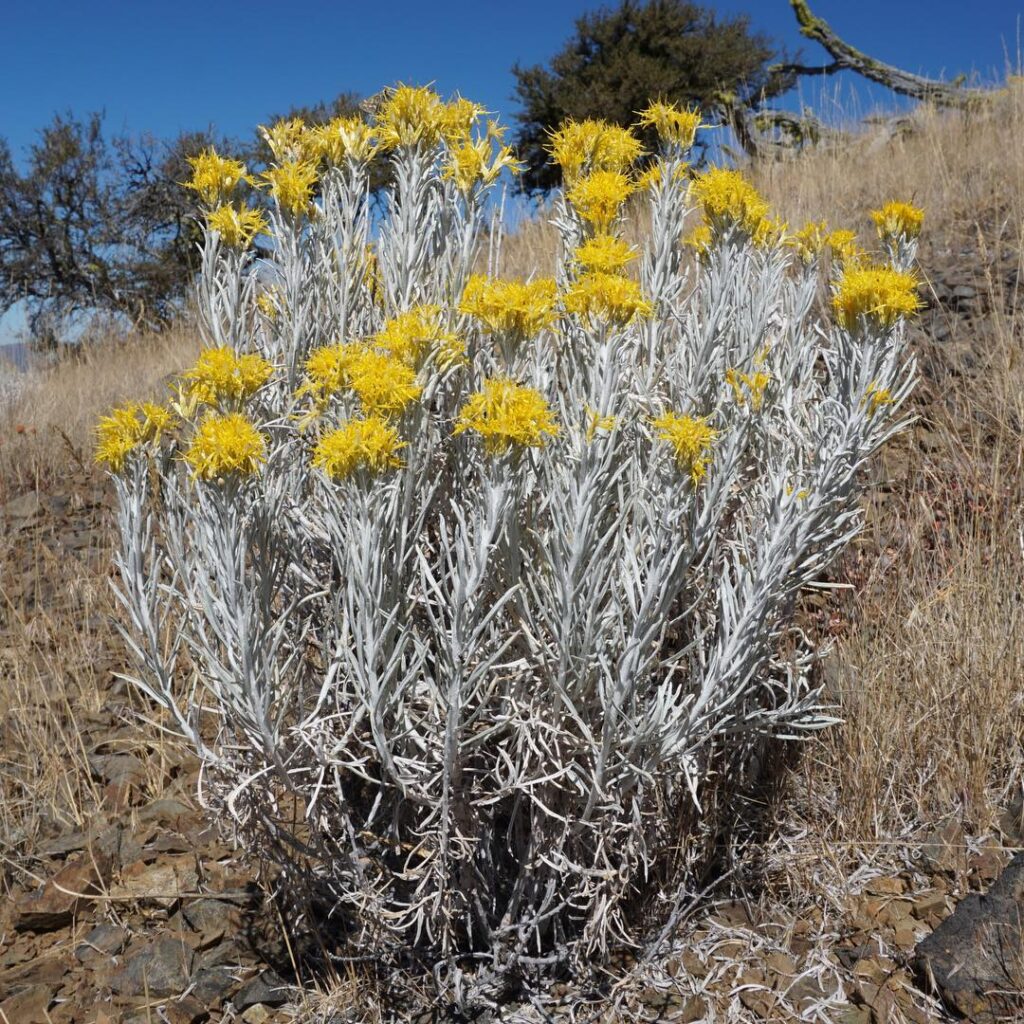
Rubber rabbitbrush is a hardy native shrub that exemplifies Wyoming’s resilient plant life. Growing 2-8 feet tall with a distinctive rounded crown, this member of the sunflower family features silvery-white felt-like hairs covering its flexible stems and narrow leaves. From August through November, it produces clusters of bright yellow flowers that add vibrant color to the autumn landscape.
This adaptable shrub thrives across diverse western habitats, from Wyoming’s windswept plains to California’s dry slopes. Its dense, feathery foliage and flexible stems help it withstand harsh conditions, while its deep root system stabilizes soil in disturbed areas. Also known as chamisa or gray rabbitbrush, this plant has served multiple purposes, including providing yellow dye for Navajo traditional uses. The plant offers special value to native bee populations, making it an excellent choice for pollinator-friendly landscaping.
- Hardiness: USDA zones 4-8, extremely cold tolerant
- Light: Full sun
- Water: Low to very low; drought tolerant once established
- Soil: Well-drained, tolerates poor and alkaline soils
- Fertilizer: None required; thrives in nutrient-poor conditions
- Pest/Disease Resistance: Excellent; very few issues
- Growth Rate: Moderate to fast
Fourwing Saltbush

Fourwing Saltbush is a hardy, drought-tolerant shrub native to Wyoming’s arid regions. This 2-6 foot perennial forms dense, rounded clumps with distinctive silvery-gray foliage that reflects sunlight to conserve moisture. Named for its distinctive four-winged seeds, this versatile shrub excels in harsh conditions where other plants struggle.
Essential for wildlife habitat, Fourwing Saltbush provides critical winter forage for pronghorn, deer, elk, and livestock when other browse is scarce. Its dense branching offers shelter and nesting sites for birds and small mammals, while seeds support various wildlife species. The plant also attracts pollinators like bees and butterflies to the garden ecosystem. The extensive root system makes it invaluable for erosion control and soil stabilization on slopes and disturbed sites.
- Hardiness: USDA Zones 2-10, extremely cold and heat tolerant
- Light: Full sun preferred
- Water: Very drought tolerant, requires only 8-12 inches annual rainfall
- Soil: Highly adaptable to poor, saline, alkaline, and calcareous soils; prefers well-drained conditions
- Fertilizer: None required, thrives in nutrient-poor soils
- Pest/Disease Resistance: Excellent resistance to pests and diseases
- Growth Rate: Moderate, spreads slowly by seed dispersal
Selecting the Right Native Plants for Your Garden
When you’re choosing native plants for your Wyoming garden, success depends on matching the right species to your specific site conditions. Start by observing your yard’s sun exposure, soil type, and wind patterns throughout different seasons.
Most Wyoming natives thrive in full sun conditions. Proper soil preparation involves testing drainage and pH levels before planting. Clay soils need amendments, while sandy areas may require different approaches.
Consider including diverse plant types like Erigeron wildflowers and native shrubs. These support local pollinators while requiring minimal maintenance once established. Native plants are naturally adapted to Wyoming’s diverse elevations, temperature fluctuations, snow, rainfall, wind, and soil conditions. Effective planting techniques include watering regularly during the first year, even for drought-tolerant species.
Frequently Asked Questions
How Long Does It Take for Native Wyoming Plants to Establish?
Rome wasn’t built in a day, and neither are Wyoming’s native plants. Your establishment timeline varies from weeks for annuals to multiple seasons for trees, depending on growth factors like water availability, soil conditions, and species selection.
Can Wyoming Native Plants Survive in Containers or Raised Beds?
You can successfully grow Wyoming native plants in containers and raised beds with proper care. Container gardening and raised bed gardening work well for smaller grasses and herbs, though you’ll need larger containers for woody plants.
What Soil Amendments Work Best for Wyoming Native Plants?
Think of soil as your plants’ foundation – you’ll want to improve Wyoming’s alkaline soil composition through organic amendment types like compost, peat moss, and mulch, while avoiding lime that raises pH further.
When Is the Optimal Time to Plant Native Species in Wyoming?
You’ll find ideal planting times are late May through early June for spring planting after frost danger passes, or late summer for fall planting allowing natural overwintering and spring germination cycles.
Do Wyoming Native Plants Require Special Fertilizers or Nutrients?
You don’t need special fertilizers for Wyoming native plants since they’ve adapted to nutrient-poor soils. Their nutrient requirements are minimal – occasionally nitrogen or iron, but standard complete fertilizers work fine when needed.
